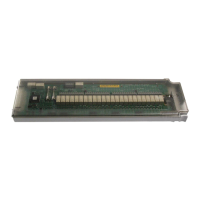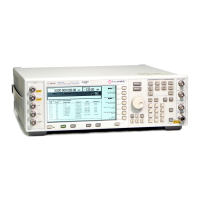1-53
Troubleshooting
Troubleshooting Assembly–Level Problems
1203 40 GHz Doubler
1. Disconnect the 0 to 20 GHz cable between the A30 Modulation Filter and the A27 40 GHz
Doubler, and connect a spectrum analyzer to the cable.
2. Tune the source from 250 kHz to 20 GHz, and record the lowest power level.
3. Disconnect the 10 to 20 GHz cable that comes from the A30 Modulation Filter, and connect the
spectrum analyzer to this cable.
4. Tune the source from 20 GHz to 40 GHz, recording the lowest power level.
5. Compare the levels recorded to the levels shown on the RF Path Block Diagrams on page 1-109.
• If both power levels are good, replace the A27 40 GHz Doubler.
• If either power level is bad, troubleshoot the path.
1204 RF Path
This test checks for a dc voltage on the A10 ALC from the A23 Lowband Coupler/Detector and
A24 Highband Coupler and A25 Highband Detector.
1. Connect a spectrum analyzer to the RF output of the signal generator.
2. Turn the RF power on and verify the presence of an RF signal on the output.
• If no RF signal is present, troubleshoot the RF problem using the RF Path procedure.
3. If an RF signal is present on the RF output, set the signal generator to 4 GHz and 0 dBm.
4. Measure the dc voltage on the cable going to J3 of the A10 ALC. The signal should be
> –600 mV.
• If the signal at J3 is good, go to step Step 6.
5. If no dc signal is present on the cable to J3, check the output at the highband detector.
• If the signal is good at the detector, replace the cable.
• If no signal is present at the output of the highband detector, replace the highband detector.
6. If the signal is good at J3, set the signal generator’s frequency to <1 GHz, the power to 0 dBm,
and measure the dc voltage on the cable going to J5 on the A10 ALC.
• If the dc voltage is –5.25 Vdc, replace the A10 ALC.
7. If other dc voltages are present, check for dc voltage on the output of the lowband detector.
• If a dc voltage is present, replace the cable.
• If no dc voltage is present, replace the lowband detector.

